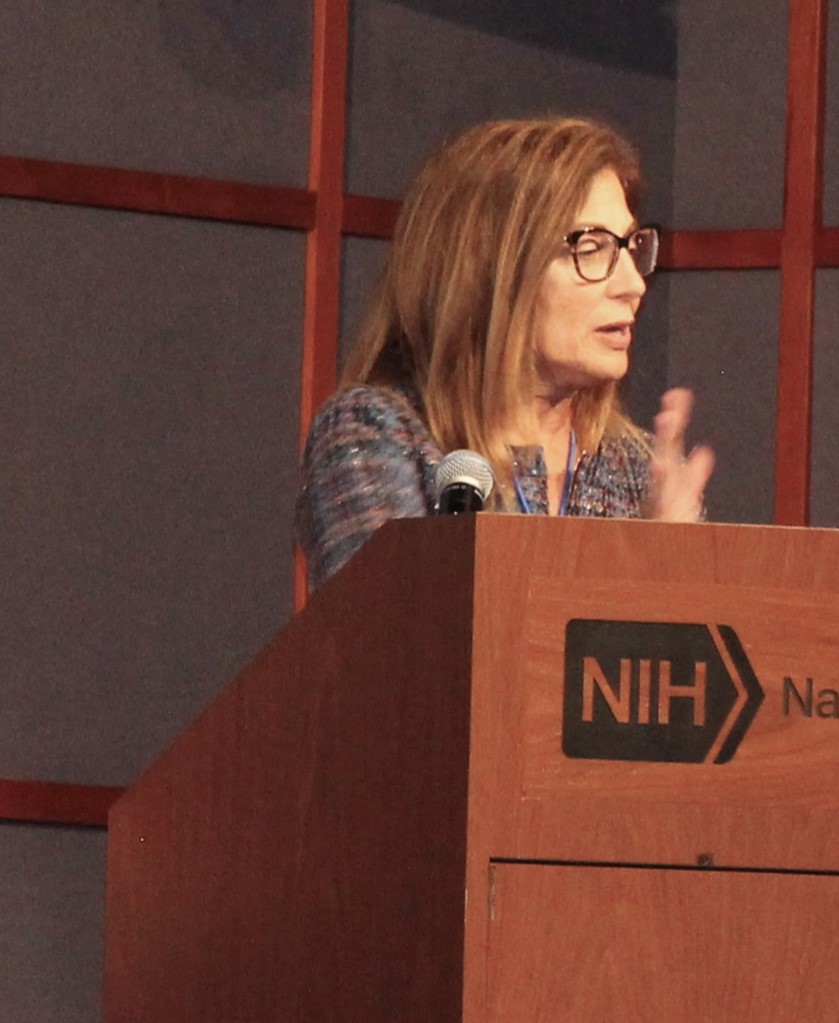Welcome - IMAG, MSM, ECI, Mentors, Visitors!
2023 MSM Co-Organizers (from left): Herbert Sauro, Denise Kirshner, Jason Haugh, Bruce Lee
Logistics for the meeting - Rules of the bells
History of IMAG - 20 years! - Grace Peng
- Presentation
Keynote - Lessons from the Past - Denise Kirschner

- Presentation
HERE :
Comment
How do we build MSMs?
What scale? Top down, bottom up?
Various Biological scales - various models may apply.
How to connect the models - issues around linking - no standards. Lots to be done.
How do we calibrate models? By eye with data fitting or other regression methods?
What are you calibrating to? Single trend line? A Range of data for each time point? - Different methods for different data.
CaliPrio: Calibration protocol for complex models.
Can match to both spatial and temporal data.
What about bayesian approaches? Stay tuned! Lots of work on this.
How do we simulate MSMs that are usually hybrid?
Find linking points to connect models at different time scales.
Significant numerical challenges with hybrid MSMs.
Need to decide: Coarse-grain vs. Fine-grain modeling - this can help with computation.
Tunable resolution to determine whether to coarse or fine grain your model.
How do we ensure MSM are robust/credible? - 10 requirements of credibility.
How do we analyze MSMs? - Key analysis Tools - uncertainty analysis, sensitivity analysis. KEY FEATURE - can quantify relationships over time
Programs available on their website in R and MatLab.
How do we validate MSMs?
Spatial vs temporal data validation - 2D vs 3D issues in multiscale modeling
When is it OK to use a 2D model?
Bottom line - if you are thinking about movement in space, you need 3D, otherwise 2D can be sufficient.
How can MSMs be useful? - many past and current applicaitons !
Future - digital partners
The Ying and Yang of biological modeling - coupled wet-lab and in silico studies for validation and prediction.
Where to go from here? Crosstalk, share ideas, maybe a big project, are mathematics still needed? Is AI/ML the answer? No. Use mechanistic models, not black box models.
What are the potential synergies of combining multiscale modeling with Generative AI?
Asif asked about generative AI and synergies.
Generative AI may be used as a supporting tool that handles human language while other tools are more suitable for some tasks of modeling. So Generative AI can be used to collect data and clean it for consumption of other tools. This is the general idea.
Will be happy to discuss details.
i agree that it should be used in tandem. I was being provocative to stimulate discussion.
I think there are many synergies and i think the breakout session on AI today will dive deeply into this topic. We do not yet know all the ways AI can interface with MSM.
What lessons/advice do you have for building and sustaining productive collaborations between experimental, clinical, and computational research groups?
Hello! Excellent question. My first response is to learn to not speak in math terms but translate clearly the biological questions you are interested in to someone you identify and let them know what kinds of questions you can help THEM answer....I identified a wetlab collaborator 22 years ago and we still have a productive ...cold call/email people who are working on the exact problems you are interested in. we can talk more in person if you like.
.
Denise asked:
Q: Are mathematics still needed?
A: Yes, math builds th foundation of the computational tools we have. We just see it less since we now code them as functions that are being used in code. So we feel like we don't do math, yet it is under the hood. And we will have to develop these tools. Yet just like we drive cars and don't look into the mechanics of making the car work while driving, math will be a necessary, yet less visible. Some people will specialize in that - yet there may be less of them since the number of tools we have coded is already very large and people are using those.
Q: Is AI/ML the answer?
A: AI/ML is a form of automation. What drives it is computing power. The same computing power applied to traditional models can be considered AI. and a lot of ML is based on the idea of optimization of a large function that is used heavily in modeling applications - so doing regression is a type of ML. However, there have been recent advances in AI, especially in the last 5 years that were able to make those tools very attractive - they don't fit everything, yet indeed are powerful and should be used more in applications related to multiscale modeling - they can solve intermediate problems very well.
Q: Use mechanistic models, not black box models. ?
A: Actually, ML models are not necessarily black boxes - they are just harder to understand because there are many small elements there and it hard for a human to follow all the tiny little details. Its just like following a population of humans where each one behaves differently - you may understand a single human, yet comprehending a large population is harder. When starting to accumulate many mechanistic models, the problem will become similar - the models will interact, compete and collaborate and although each single model can be human comprehensible due to mechanistic nature, a larger collective will become more like a black box. Nevertheless, there are ways to combine many mechanistic models together and maintain things comprehensible, while still using machine learning tools - I am writing this from experience. I believe that a middle ground of combining the technologies will be useful to explain things.
By the way, from current experience it seems that multiscale models when combined with others enhance things...
Will be happy to talk more about those topics.



Thanks Grace for kicking off the meeting with your perspectives! - Reed